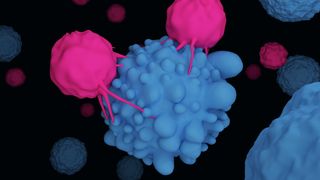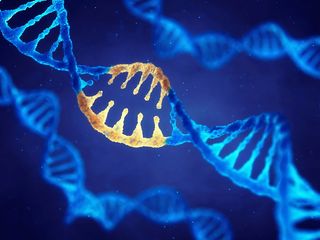Take That Back: The Top Scientific Retractions of 2019
"If it disagrees with experiment, it's wrong. That's all there is to it." So said famed physicist Richard Feynman at a lecture about the scientific method at Cornell University in 1964.
Feynman appears to be only half correct, though. Yes, one's proposed theory is wrong if it doesn't agree with experiment. But that's not all there is to it. With carelessness or outright fraud, you can make it seem that your theory is correct — and get it published in a top scientific journal.
Usually, such deception is eventually discovered. This past year was rich in scientific retractions of papers filled with poor processes and, in many cases, blatant fabrications. Here are five from 2019 that made the news in part because they mislead and provide false hope.
5. Creationist's paper retracted '20 million years' later

God created the Earth 6,000 years ago, according to many Christian creationists. And on the sixth day of creation, God made three species of timber vole with ribonucleotides that would come to demonstrate the shortcomings of the theory of evolution, according to a 1989 paper in the International Journal of Neuroscience.
Russian scientist Dmitrii Kuznetsov, the author of this paper, claimed that each of these three very closely related voles have ribonucleotides — enzymes that are the building blocks of DNA and thus DNA repair — that are utterly incompatible across the three species. This finding supports "the general creationist concept on the problems of the origin of boundless multitudes of different and harmonically functioning forms of life," Kuznetsov wrote in the paper.
But did Kuznetsov break the commandment about bearing false witness? Swedish biologist Dan Larhammar, who in 2018 became president of the Royal Swedish Academy of Sciences, questioned Kuznetsov's findings in a letter to the journal published way back in 1994. As reported in The Scientist in November 2019, Larhammar claimed that the results were superficially demonstrated and that many of the references couldn't be verified, even after he contacted scientists cited in the paper.
The International Journal of Neuroscience agreed with Larhammar and retracted the paper, albeit 30 years later. Kuznetsov has been accused multiple times of scientific misconduct, including for his analysis of the Shroud of Turin, which scholars claim originated in the Middle Ages but which Kuznetsov suggested could be the 2,000-year-old death shroud of Jesus.
Sign up for the Live Science daily newsletter now
Get the world’s most fascinating discoveries delivered straight to your inbox.
Why the 30-year delay for a retraction? Thirty years in a 6,000-year-old Earth would be equivalent to 20 million years in a 4-billion-year-old Earth. Maybe the journal was hesitant to retype the original title, "In Vitro Studies of Interactions Between Frequent and Unique Mrnas and Cytoplasmic Factors from Brain Tissue of Several Species of Wild Timber Voles of Northern Eurasia, Clethrionomys Glareolus, Clethrionomys Frater and Clethrionomys Gapperi: A New Criticism to a Modern Molecular-Genetic Concept of Biological Evolution."
4. HPV vaccine vindicated once again

The vaccine against the human papillomavirus (HPV) has the potential to eliminate most cases of cervical cancer worldwide and save millions of lives. The HPV vaccine can also prevent the majority of vaginal, anal and penile cancers. But that's only if parents vaccinate their children against HPV.
A growing number are opting out over fears that the HPV vaccine is harmful. In Japan, for example, HPV vaccination rates fell from about 70 percent to 1 percent, its current level, in just a few years after unfounded reports of vaccine side effects, according to research published this year in the journal Expert Review of Vaccines.
As such, vaccine proponents are skeptical of any new study purporting problems with the HPV vaccine. Gayle DeLong, an associate professor of economics and finance at Baruch College in New York, learned that quickly. In 2018, she published a paper in the Journal of Toxicology and Environmental Health, Part A, in which she reported a link between the HPV vaccine and infertility. Married women between ages 25 and 29 who had received the HPV vaccine were less likely to have conceived compared with married women who didn't receive the vaccine, DeLong found.
The finding was promoted within anti-vaccination circles, but the study had multiple statistical shortcomings, such as not controlling for birth-control use. Moreover, those women who received the vaccine had a higher educational level. So, it could be that college-educated women who had received the vaccine were delaying childbirth until after age 30, as is the U.S. trend.
The journal retracted the paper in December 2019, noting "serious flaws in the statistical analysis and interpretation of the data in this paper." The World Health Organization has placed the HPV vaccine on its list of essential medicines, right up there with penicillin and acetaminophen, as a sign of its safety and efficacy.
3. What happens when the fraud czar is accused of fraud?

On Nov. 13, 2019, Cao Xuetao, one of China's most prominent scientists, spoke to his fellow countrymen from the Great Hall of People in Beijing about research integrity. Some 6,000 people were in attendance, and the speech was live-streamed to 800,000 college students across the vast nation, mandatory viewing for most.
The topic was a contentious one. Just a year prior, the Chinese Ministry of Science and Technology (MOST) and several other agencies had promulgated a series of punitive measures to be used in cases of scientific misconduct, a sign that the Chinese government was considering the matter seriously. This had come in the wake of numerous scientific scandals in China, such as the retraction of more than 100 papers in 2017 over faked peer review and data manipulation.
Cao is a former president of the Chinese Academy of Medical Sciences, current president of the prestigious Nankai University, leader of several labs and chief research integrity officer for all Chinese research. His accolades are many. But now, Cao's actions are drawing close scrutiny, as he has been accused of scientific misconduct.
As reported on Nov. 22 in the journal Science, a multitude of Cao's papers appear to have doctored images. Science sleuth Elisabeth Bik, based in San Francisco, noticed that several images from a 2009 paper, in particular, looked like repeats. Bik has outed many scientists for data manipulation. Cao's body of work was soon scrutinized; they found examples of charts and images appearing to be repeated and manipulated in dozens of papers, which soon may be retracted.
Cao pledged to look into the matter. As noted, he's the leader of several labs and has a full-time gig as a university president, and he likely relies on postdoctoral fellows and graduate students to conduct actual research. And they likely want to please the boss with superficially good results. The same would apply to other elite scientists in China, which means the problem of scientific misconduct might be difficult to root out.
2. CAR T study carted off to the retraction heap

The cancer research community was ecstatic over a study published in the journal Nature in September 2018 that described a homing system to deliver the powerful anti-cancer chimeric antigen receptor (CAR) T cell therapy to brain cancer cells, which have long been out of reach to drug therapies.
But the researchers who conducted the study, from Baylor College of Medicine in Texas, may not have crossed the blood–brain barrier, after all, but rather the fact–fiction barrier.
Within a few weeks of publication, other scientists began homing in on what may be widespread image manipulation. Nearly every image appeared to be fudged and not supportive of the underlying data, according to comments posted on an anonymous post-publication peer-review website called PubPeer.
The journal Nature investigated and retracted the paper in February 2019. The validity of this homing system remains in doubt. Some commenters on PubPeer noted that Nature should have spotted the image manipulation during the peer-review process. Software exists to detect it. It's either that or expect scientists to be honest.
1. 'CRISPR Baby' scientist retracted from public view

He Jiankui has not been seen publicly since January 2019, just a few months after he infamously announced the birth of twin girls whose DNA was edited using CRISPR. His plan was to make the girls immune to HIV infection by modifying a gene known to offer some protection against the virus.
Seemingly proud of his achievement, He encountered swift worldwide condemnation — not merely over the secrecy of the experiment but also for the possible harm that could have been done to the babies, whose genes were manipulated while in an embryonic state. CRISPR is an imperfect technique that can alter DNA in unknown and sometimes harmful ways, as animal studies have demonstrated.
The Chinese government, which may have supported He's efforts, has since suspended all of his research activities and, according to the New York Times, has kept him under guard.
Not much is known about He's procedure. Here's what is known: Scientists have stated that the basic premise of the work — altering a gene called CCR5 to prevent HIV infection — is shortsighted because this altered gene, found in nature, does not offer uniform HIV protection to those people who carry it. Moreover, the twins were given imperfect versions of this altered gene, and the health consequences are unknown, according to investigative work done by MIT Technology Review.
So, this was an experimental study otherwise suitable only for lab animals, medically unnecessary and poorly executed at that. There was a third gene-edited baby, too, perhaps born in the summer of 2019. Nothing is known of the baby's fate.
At issue is germline gene-editing on embryos. Gene alteration at this early stage ensures that all genetic modifications are copied into every cell in the body, including egg and sperm cells, making the changes inheritable. Otherwise, CRISPR and similar technologies continue to show great promise in curing genetic diseases in children and adults through more isolated and limited gene modification.
- The 10 Strangest Animal Stories of 2019
- 16 Times Antarctica Revealed Its Awesomeness in 2019
- 10 Times Nature Was Totally Metal in 2019
- The 10 Biggest Archaeology Discoveries of 2019
- 9 Epic Space Discoveries You Probably Missed in 2019
Originally published on Live Science.

Christopher Wanjek is a Live Science contributor and a health and science writer. He is the author of three science books: Spacefarers (2020), Food at Work (2005) and Bad Medicine (2003). His "Food at Work" book and project, concerning workers' health, safety and productivity, was commissioned by the U.N.'s International Labor Organization. For Live Science, Christopher covers public health, nutrition and biology, and he has written extensively for The Washington Post and Sky & Telescope among others, as well as for the NASA Goddard Space Flight Center, where he was a senior writer. Christopher holds a Master of Health degree from Harvard School of Public Health and a degree in journalism from Temple University.
-
Xufang Bai Not long ago, one of my friends from a big pharmaceutical told me they cannot repeat the experiments published in top journals like Nature and Science...I do have some personal experiences readers here might have interests.Reply
Tau is the best index to describe left ventricular diastolic function. 1992, a formula was developed based on FOUR BOLD assumptions and validated at Harvard to measure it. 5 years later, a formal validation was completed at Cleveland and the result was published in a top journal. However, the formula is wrong. I am still curious that how people can prove an incorrect theory with decent experiment.
https://pubpeer.com/publications/45F9A57F317015A6A01AF2CFF9AE8A#1
The truth is I developed the formulas without any of those assumptions to measure Tau. One of my formulas has been already integrated into Mindray's Echo machines sold all over the world except North America. Researchers found it hard for their work based on my formulas to get published in main stream journals due to the Harvard method. My opinion is these two papers should be retracted:
https://pubmed.ncbi.nlm.nih.gov/1442500-isovolumic-relaxation-time-varies-predictably-with-its-time-constant-and-aortic-and-left-atrial-pressures-implications-for-the-noninvasive-evaluation-of-ventricular-relaxation/
https://pubmed.ncbi.nlm.nih.gov/?term=Noninvasive+Assessment+of+the+Ventricular+Relaxation+Time+Constant+%28%CF%84%29+in+Humans+by+Doppler+Echocardiography
Anybody can give me any advises how to get it done?
Most Popular

